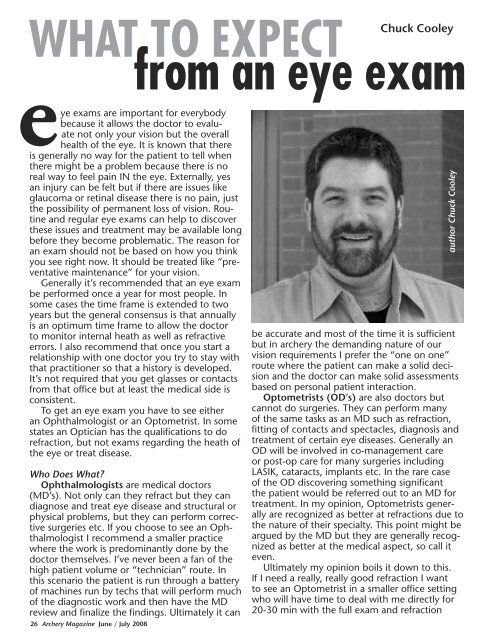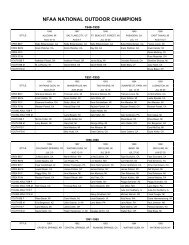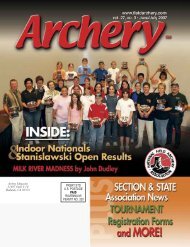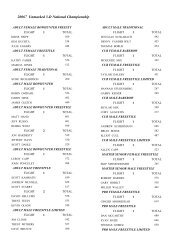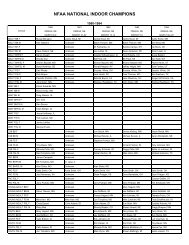the 2008 national indoor results - National Field Archery Association
the 2008 national indoor results - National Field Archery Association
the 2008 national indoor results - National Field Archery Association
You also want an ePaper? Increase the reach of your titles
YUMPU automatically turns print PDFs into web optimized ePapers that Google loves.
WHAT TO EXPECT<br />
ye exams are important for everybody<br />
because it allows <strong>the</strong> doctor to evaluate<br />
not only your vision but <strong>the</strong> overall<br />
health of <strong>the</strong> eye. It is known that <strong>the</strong>re<br />
is generally no way for <strong>the</strong> patient to tell when<br />
<strong>the</strong>re might be a problem because <strong>the</strong>re is no<br />
real way to feel pain IN <strong>the</strong> eye. Externally, yes<br />
an injury can be felt but if <strong>the</strong>re are issues like<br />
glaucoma or retinal disease <strong>the</strong>re is no pain, just<br />
<strong>the</strong> possibility of permanent loss of vision. Routine<br />
and regular eye exams can help to discover<br />
<strong>the</strong>se issues and treatment may be available long<br />
before <strong>the</strong>y become problematic. The reason for<br />
an exam should not be based on how you think<br />
you see right now. It should be treated like “preventative<br />
maintenance” for your vision.<br />
Generally it’s recommended that an eye exam<br />
be performed once a year for most people. In<br />
some cases <strong>the</strong> time frame is extended to two<br />
years but <strong>the</strong> general consensus is that annually<br />
is an optimum time frame to allow <strong>the</strong> doctor<br />
to monitor internal heath as well as refractive<br />
errors. I also recommend that once you start a<br />
relationship with one doctor you try to stay with<br />
that practitioner so that a history is developed.<br />
It’s not required that you get glasses or contacts<br />
from that office but at least <strong>the</strong> medical side is<br />
consistent.<br />
To get an eye exam you have to see ei<strong>the</strong>r<br />
an Ophthalmologist or an Optometrist. In some<br />
states an Optician has <strong>the</strong> qualifications to do<br />
refraction, but not exams regarding <strong>the</strong> heath of<br />
<strong>the</strong> eye or treat disease.<br />
Who Does What?<br />
Ophthalmologists are medical doctors<br />
(MD’s). Not only can <strong>the</strong>y refract but <strong>the</strong>y can<br />
diagnose and treat eye disease and structural or<br />
physical problems, but <strong>the</strong>y can perform corrective<br />
surgeries etc. If you choose to see an Ophthalmologist<br />
I recommend a smaller practice<br />
where <strong>the</strong> work is predominantly done by <strong>the</strong><br />
doctor <strong>the</strong>mselves. I’ve never been a fan of <strong>the</strong><br />
high patient volume or “technician” route. In<br />
this scenario <strong>the</strong> patient is run through a battery<br />
of machines run by techs that will perform much<br />
of <strong>the</strong> diagnostic work and <strong>the</strong>n have <strong>the</strong> MD<br />
review and finalize <strong>the</strong> findings. Ultimately it can<br />
Chuck Cooley<br />
from an eye exam<br />
author Chuck Cooley<br />
be accurate and most of <strong>the</strong> time it is sufficient<br />
but in archery <strong>the</strong> demanding nature of our<br />
vision requirements I prefer <strong>the</strong> “one on one”<br />
route where <strong>the</strong> patient can make a solid decision<br />
and <strong>the</strong> doctor can make solid assessments<br />
based on personal patient interaction.<br />
Optometrists (OD’s) are also doctors but<br />
cannot do surgeries. They can perform many<br />
of <strong>the</strong> same tasks as an MD such as refraction,<br />
fitting of contacts and spectacles, diagnosis and<br />
treatment of certain eye diseases. Generally an<br />
OD will be involved in co-management care<br />
or post-op care for many surgeries including<br />
LASIK, cataracts, implants etc. In <strong>the</strong> rare case<br />
of <strong>the</strong> OD discovering something significant<br />
<strong>the</strong> patient would be referred out to an MD for<br />
treatment. In my opinion, Optometrists generally<br />
are recognized as better at refractions due to<br />
<strong>the</strong> nature of <strong>the</strong>ir specialty. This point might be<br />
argued by <strong>the</strong> MD but <strong>the</strong>y are generally recognized<br />
as better at <strong>the</strong> medical aspect, so call it<br />
even.<br />
Ultimately my opinion boils it down to this.<br />
If I need a really, really good refraction I want<br />
to see an Optometrist in a smaller office setting<br />
who will have time to deal with me directly for<br />
20-30 min with <strong>the</strong> full exam and refraction<br />
done personally by <strong>the</strong> OD. If I need surgery or<br />
have something significant to deal with <strong>the</strong>n I’m<br />
off to <strong>the</strong> MD.<br />
An Optician will use <strong>the</strong> refraction provided<br />
during <strong>the</strong> exam to fabricate a pair of glasses.<br />
Occasionally <strong>the</strong> optician can fit contacts as well<br />
but most often that is reserved for <strong>the</strong> doctor.<br />
Again <strong>the</strong> optician should be asking several<br />
“lifestyle” questions to determine how you use<br />
your eyes on a day to day basis. This will include<br />
lifestyle questions for hobbies and sports, work<br />
related questions about how you “see”. This<br />
information helps <strong>the</strong>m determine what style of<br />
frame and lens you should<br />
be using for each activity.<br />
Often times for best performance<br />
this might mean<br />
multiple pairs of glasses.<br />
The Exam<br />
An eye exam is a series<br />
of tests to determine several<br />
things about your eyes. The good news is<br />
that it doesn’t hurt and you don’t have to study<br />
for it. During <strong>the</strong> initial portion of <strong>the</strong> exam you<br />
and <strong>the</strong> doctor or his assistant will discuss basic<br />
history and what if any your visual complaints<br />
are.<br />
This will lead to a quick look at <strong>the</strong> eye with<br />
a light to make sure <strong>the</strong> basic external functions<br />
are all working properly, and <strong>the</strong>n a check of<br />
your visual acuity with and without <strong>the</strong> current<br />
glasses.<br />
They may start with a visual fields test. This<br />
test determines your blind spots or how big your<br />
field of view is. If you were to have a problem in<br />
your peripheral vision or an exaggerated blind<br />
spot it may be an indicator of a problem in <strong>the</strong><br />
eye. This test can be as simple as following a pen<br />
or light from side to side or as advanced as using<br />
specialized equipment to actually map how your<br />
eye sees light.<br />
From here <strong>the</strong> exam moves forward in great<br />
detail. It will include <strong>the</strong> visual acuity and refraction<br />
aspect where <strong>the</strong> doctor will use various<br />
methods to determine how well you are seeing.<br />
The primary method is retinoscopy. This is a<br />
hand held bright light used by <strong>the</strong> doctor to<br />
determine <strong>the</strong> refractive error. Sometimes an<br />
auto refractor machine is used instead to evaluate<br />
<strong>the</strong> error. Then by showing you a series of<br />
trial lenses dialed in a phoropter <strong>the</strong>y will fine<br />
tune and determine <strong>the</strong> new correction. This is<br />
typically where you get <strong>the</strong> “better 1 or 2” kind<br />
of questions. The really important part from<br />
<strong>the</strong> patient perspective here is to not cheat. No<br />
squinting and no “guessing”. Every answer you<br />
give to <strong>the</strong> doctor has a specific reaction. If you<br />
cheat <strong>the</strong> answers you can expect to have problems<br />
with your glasses. No matter how good<br />
<strong>the</strong> refractionist is, bad answers get bad <strong>results</strong>.<br />
Although this portion of <strong>the</strong> prescription is a<br />
blend of objective and subjective information<br />
gleaned during <strong>the</strong> process. Generally a really<br />
good examination will uncover <strong>the</strong> inconsistent<br />
responses but it still might not lead to <strong>the</strong> best<br />
possible result.<br />
You should also expect a slit lamp exam. This<br />
is a type of microscope tool <strong>the</strong> doctor will use<br />
to look into <strong>the</strong> eye for<br />
abnormalities internally as<br />
well as on <strong>the</strong> cornea. It<br />
has a very bright light that<br />
can be shown in different<br />
colors. Using an orange dye<br />
eye drop that <strong>the</strong> doctor<br />
puts in <strong>the</strong>y can see if <strong>the</strong>re<br />
any surface problems like<br />
scarring or infections.<br />
The doctor will also do a retinal exam. During<br />
this procedure <strong>the</strong> doctor is looking at <strong>the</strong> back<br />
structures of <strong>the</strong> eye. Specifically <strong>the</strong>y look at <strong>the</strong><br />
retina, <strong>the</strong> optic disc, and <strong>the</strong> blood vessels that<br />
feed <strong>the</strong> eyeball. Depending on <strong>the</strong> in-depth<br />
nature of <strong>the</strong> exam <strong>the</strong> doctor may also dilate<br />
<strong>the</strong> pupil to get a better look at <strong>the</strong> structures<br />
especially in <strong>the</strong> case of stronger corrections or<br />
if <strong>the</strong>re is a history of ocular disease. The dilation<br />
is not always mandatory, but it certainly is helpful.<br />
Tonometry is a very important part of an eye<br />
exam as well. It is a determination of internal<br />
pressure in <strong>the</strong> eye. An elevated pressure would<br />
indicate glaucoma. It can be treated with medication<br />
but left untreated elevated pressures can<br />
lead to blindness.<br />
There are o<strong>the</strong>r tests that <strong>the</strong> doctor may do<br />
during <strong>the</strong> exam to help answer more complex<br />
questions that may come up or to deal with specific<br />
eye health history issues, but for <strong>the</strong> most<br />
part <strong>the</strong>se are <strong>the</strong> basic aspects that you should<br />
expect during an exam.<br />
Top 10 Tips<br />
One of <strong>the</strong> most important parts of an exam<br />
is who is doing it. This is probably <strong>the</strong> most difficult<br />
part of <strong>the</strong> whole thing. The following is<br />
just a guideline and <strong>the</strong>re are always exceptions<br />
to <strong>the</strong> rule but in my experience I recommend<br />
some of <strong>the</strong> following tips.<br />
continued on pg. 28<br />
26 <strong>Archery</strong> Magazine June / July <strong>2008</strong> <strong>Archery</strong> Magazine June / July <strong>2008</strong> 27


